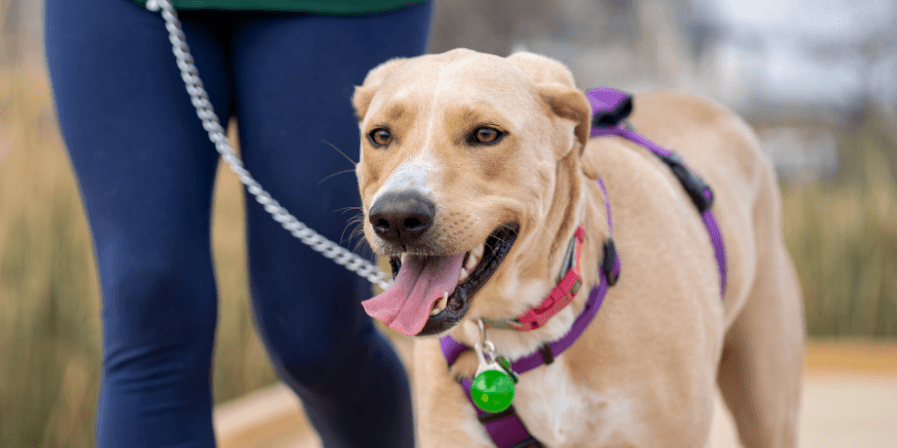How Often Should You Walk Your Dog?

Walking your dog is more than just an opportunity for them to relieve themselves—it's a crucial part of maintaining their health, happiness, and overall well-being. However, determining how often you should walk your dog isn't a one-size-fits-all answer. It depends on factors like breed, age, exercise tolerance, and your personal schedule.
Let’s explore these aspects in detail to help you develop the best walking routine for your furry friend.
Dog Breed
The breed of your dog plays a significant role in how much exercise they need. Active breeds such as Border Collies, Australian Shepherds, and Labrador Retrievers require plenty of physical activity to keep them engaged and healthy. These dogs have higher energy levels and can easily become restless or bored without sufficient exercise. To keep them mentally and physically stimulated, it's important to ensure they get more frequent and longer walks, sometimes twice or even three times a day.
In contrast, more laid-back breeds like Bulldogs, Basset Hounds, and Shih Tzus don't have the same high-energy needs and are usually content with shorter, leisurely walks. For these dogs, long daily walks might not be necessary, and they may be happy with a short stroll around the block once or twice a day. Knowing your dog's breed-specific exercise requirements is essential to striking the right balance in their walking routine.
Age
Your dog's age also plays a key role in determining the ideal frequency of walks. Puppies, for instance, are full of energy and curiosity, and they usually require several walks a day, combined with playtime and exploration. However, puppies have shorter attention spans and may tire more quickly than adult dogs, so shorter walks are ideal to start with. As they grow, you can gradually increase the length and frequency of their walks as their stamina improves.
For adult dogs, a consistent walking routine is typically enough to keep them healthy and fit. While adult dogs need regular walks to maintain their physical and mental health, the duration and intensity can be adjusted depending on the breed and activity levels. On average, most adult dogs benefit from one or two walks per day, each lasting anywhere from 20 to 30 minutes, depending on their needs.
When it comes to senior dogs, things change once again. As dogs age, their energy levels decline, and they may develop health issues like arthritis or joint pain, making long or intense walks more difficult. For older dogs, it’s important to keep walks slow and gentle. Focus on shorter walks at a relaxed pace, and avoid overexerting them. These walks should be less about exercise and more about comfort and quality of life, with plenty of breaks and opportunities for sniffing around.
Your Dog’s Exercise Tolerance
Not all dogs have the same level of exercise tolerance. Some dogs have naturally high energy and can easily handle long walks, while others may tire quickly, especially if they are older or dealing with health issues. If you are unsure about how much exercise your dog can handle, pay close attention to their behavior during walks.
Dogs who struggle with their tolerance may show signs of exhaustion, such as excessive panting, slowing down, or limping. If you notice these signs, it’s essential to stop the walk, offer them water, and allow them to rest. Over time, you can help improve their stamina by gradually increasing the duration of walks, but always be mindful of their physical condition.
If your dog has health issues like obesity, arthritis, or heart problems, it’s crucial to tailor their walking routine to their specific needs. Before making changes to their exercise routine, consider consulting your veterinarian to ensure you're not overexerting them.
How to Build a Dog’s Exercise Tolerance
Improving your dog’s exercise tolerance takes time and patience. If your dog isn't used to a lot of physical activity, it’s essential to start slowly and gradually build up their stamina. Begin with shorter, easy walks—about 10 to 15 minutes—and progressively increase the duration as your dog adapts. Watch for any signs of fatigue, and adjust accordingly. If your dog is older or recovering from an injury, it's even more important to start slowly and take it easy.
As you continue to build their tolerance, you can begin adding more intensity to the walks, either by increasing the speed, the duration, or even adding in some light jogging or playtime. Always listen to your dog’s body language, and stop if they seem uncomfortable or exhausted. Over time, your dog’s fitness will improve, and they’ll be able to handle longer or more frequent walks.
Your Schedule
Lastly, your personal schedule will affect how often you can walk your dog. For most dog owners, fitting in a walk in the morning and another in the evening is manageable, and this can meet the exercise needs of most dogs. However, if you have a very busy lifestyle or work long hours, you may need to make arrangements to ensure your dog gets enough exercise. In such cases, hiring a dog walker, utilizing doggy daycare services, or arranging a midday walk with a friend or neighbor can help ensure your dog gets the exercise they need.
If your dog is very active and needs multiple walks a day, try to make time for additional short walks or play sessions during your breaks. You can also explore other activities like fetch, dog parks, or hiking to keep your dog entertained and exercised.
Conclusion
Deciding how often to walk your dog depends on several key factors, including their breed, age, exercise tolerance, and your own schedule. While most dogs benefit from at least one walk a day, some high-energy breeds may need more frequent walks, while others may be satisfied with a leisurely stroll. Pay attention to your dog’s needs and abilities, and gradually build up their stamina to ensure they stay fit and healthy. By developing a consistent walking routine tailored to your dog’s unique needs, you’ll help them lead a happier, healthier life.
If you're unsure about your dog’s exercise needs, DCC Animal Hospital can provide expert advice tailored to your pet’s health. Whether it’s managing weight, age-related concerns, or creating a customized exercise plan, DCC Animal Hospital is committed to keeping your dog fit and happy!


 How can we help?
How can we help?